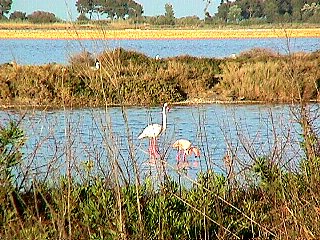    The Camargue was designated as a botanical and zoological nature reserve in 1927 and 1970, helping to maintain its natural beauty. Spring and Autumn are the best times for seeing the birds, the bulls and the horses of Camargue. Bring a bird book, binoculars and camera ... and some mosquito repellent. The Camargue was designated as a botanical and zoological nature reserve in 1927 and 1970, helping to maintain its natural beauty. Spring and Autumn are the best times for seeing the birds, the bulls and the horses of Camargue. Bring a bird book, binoculars and camera ... and some mosquito repellent.
The upper Camargue has been cultivated since the Middle Ages. The alluvium soil in the Rhone delta is excellent for crops, but must be prepared and maintained. The land had to be drained, and needs to be protected by low dikes. Salt content, which increases during summer evaporation, is reduced by washing down the soil.
Rice cultivation is done on 3-ha plots that are submerged from April to September, and harvested during September and October. Over 30,000 ha (120 square miles) of rice was grown in the early sixties, down to 10,000 ha today. Other crops include large fields of wheat, maize, rape and forage, intermixed with orchards, market gardens and even an occasional vineyard.
|
  The southeast corner of the Camargue, near Salin-de-Giraud and the Grand Rhone are the salt marshes ("salins") of Salin de Giraud. Another salt marsh, the Salins du Midi, is located in the southwest corner, west of the Petit Rhone. In the salt marshes you'll see long lines of salt "mountains" drying in the Provencal sun, and the checkerboard salt-pans. The southeast corner of the Camargue, near Salin-de-Giraud and the Grand Rhone are the salt marshes ("salins") of Salin de Giraud. Another salt marsh, the Salins du Midi, is located in the southwest corner, west of the Petit Rhone. In the salt marshes you'll see long lines of salt "mountains" drying in the Provencal sun, and the checkerboard salt-pans.
Salt production in the Camargue began in Antiquity, by both the Greeks and the Romans, and continued through the Middle ages. Salt was transported along the Mediterranean coast and then inland on the "Routes de Sel" (Salt Roads), up through the Vaucluse or the mountains of the Alpes-Maritime across the Col de Tende into Piedmont.
|



